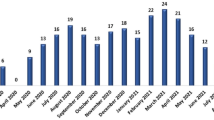Abstract
Background and aims: The nature of adverse clinical events (ACE) during duty hours (16:00-08:00 and holidays), as well as the way they are addressed by duty physicians (DP) in a nursing home (NH) are the subject of this study. Methods: Data, including medical details concerning ACEs and the resultant referrals to hospital, were collected prospectively during 183 consecutive days in a 90-bed NH. Results: Ninety-six residents experienced 370 ACEs, representing an average of one for every 44.5 patient days. The highest rate of events was during evening hours (18:00–21:00). The most prevalent ACE was fever (32%). Most cases (53%) were treated by the DPs on site. No intervention was needed in 19% of cases, whereas 28% of ACEs (104 cases) were referred to the Emergency Room (ER) of a general hospital. Sixty-six percent of these were actually admitted. The rate of ER referral of residents was one for every 158 patient days. About 40% of the referred patients had been discharged from hospital the previous week. High fever was the commonest cause for referral: 47%. During the working hours of the study period, the rate of referral by the staff physician was only 1 for every 915 patient days. Only 17% of these had high fever. Conclusions: Evening rounds by staff physicians, strengthening of working relations with hospital physicians, as well as fostering intravenous treatment in NHs, are suggested as means for reducing hospital transfers. A standardized method for the reporting of ACEs and referrals to hospitals should be adopted in order to facilitate comparisons between NHs and to evaluate its use as a quality indicator.
Similar content being viewed by others
References
The elderly in Israel: Statistical Abstract. The Joint Brookdale Institute, Jerusalem, 2001.
Beringer TR, Crawford VL, Montgomery A, Gilmore DH. Institutional care for elderly people in North and West Belfast. A decade of change from 1989–1999. Aging Clin Exp Res 2003; 15: 38–42.
Brooks S, Warshaw G, Hasse L, Kues JR. The physician decision-making process in transferring nursing home patients to the hospital. Arch Intern Med 1994; 154: 902–8.
Bernardini B, Meinecke C, Zaccarini C. Adverse clinical events in dependent long-term nursing home residents. J Am Geriatr Soc 1993; 41: 105–11.
Ackermann RJ. Nursing home practice. Strategies to manage most acute chronic illnesses without hospitalization. Geriatrics 2001; 56: 34–7.
Bergman H, Clarfield AM. Appropriateness of patient transfer from a nursing home to an acute care hospital: a study of emergency room visits and hospital admissions. J Am Geriatr Soc 1991; 39: 1164–8.
Lynn J. Hospitalization of nursing home residents: the right rate? J Am Geriatr Soc 1997; 45: 378–9.
Kayser-Jones JS, Wiener CL, Barbaccia JC. Factors contributing to the hospitalization of nursing home residents. Gerontologist 1989; 29: 502–10.
Karuza J, Katz PR. Physician staffing patterns correlates of nursing home care: an initial inquiry and consideration of policy implications. J Am Geriatr Soc 1994; 42: 787–93.
Bellelli G, Frisoni GB, Barbisoni P, Boffelli S, Rozzini R, Trabucchi M. The management of adverse clinical events in nursing homes: a 1-year survey study. J Am Geriatr Soc 2001; 49: 915–25.
Strausbaugh LJ. Infection control in long term care: news from the front. Am J Infect Control 1999; 27: 1–3.
Yoshikawa TT, Norman DC. Approach to fever and infection in the nursing home. J Am Geriatr Soc 1996; 44: 74–82.
Ackermann RJ, Kemle KA, Vogel RL, Griffin RC Jr. Emergency department use by nursing home residents. Ann Emerg Med 1998; 31: 749–57.
Ottenbacher KJ, Smith PM, Illig SB, Fiedler RC, Granger CV. Length of stay and hospital readmission for persons with disabilities. Am J Public Health 2000; 90: 1920–3.
Murtaugh CM, Freiman MP. Nursing home residents at risk of hospitalization and the characteristics of their hospital stays. Gerontologist 1995; 35: 35–43.
Experton B, Ozminkowski RJ, Pearlman DN, Li Z, Thompson S. How does managed care manage the frail elderly? The case of readmissions in fee-for-service versus HMO systems. Am J Prev Med 1999; 16: 163–72.
Leyland AH. Examining the relationship between length of stay and readmission rates for selected diagnoses in Scottish hospitals. IMA J Math Appl Med Biol 1995; 12: 175–84.
Kodner DL. The quest for integrated systems of care for frail older persons. Aging Clin Exp Res 2002; 14: 307–13.
Tresch DD. Dutthe EH. Gruchow HW. Coping with DRGs — a nursing home experience. Am J Med Sci 1989; 298: 309–13.
Teresi JA, Holmes D, Bloom HG, Monaco G Rosen S. Factors differentiating hospital transfers from long-term care facilities with high and low transfer rates. Gerontologist 1991; 31: 795–806.
Sekscenski E. Discharges from nursing homes: preliminary data from the 1985 National Nursing Home Survey. National Center for Health Statistics Advance Data, No. 142. Washington, DC: U.S. Department of Health and Human Services, 1987.
Fried TR. Mor V. Frailty and hospitalization of long term stay nursing home residents. J Am Geriatr Soc 1997; 45: 265–9.
Lewis MA, Cretin S, Kane RL. The natural history of nursing home patients. Gerontologist 1985; 25: 382–8.
Stark A. Gutman G. McCashin B. Acute care hospitalizations and long term care. J Am Geriatr Soc 1982; 30: 509–15.
Author information
Authors and Affiliations
Corresponding author
Rights and permissions
About this article
Cite this article
Leibovitz, A., Baumoehl, Y., Habot, B. et al. Management of adverse clinical events by duty physicians in a nursing home. Aging Clin Exp Res 16, 314–318 (2004). https://doi.org/10.1007/BF03324557
Received:
Accepted:
Published:
Issue Date:
DOI: https://doi.org/10.1007/BF03324557




